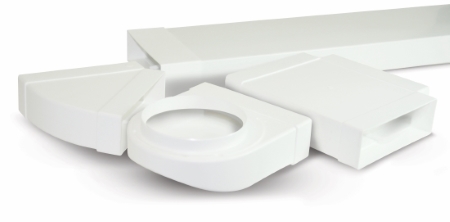A number of new types of low profile plastic duct have recently been released onto the Australian market. It is important for specifiers and installers to ensure the new product meets Australian standards and is compliant with the Building Code of Australia (BCA). This article sets out to clarify any confusion that exists around use of these products in building services.
BCA Compliance
In 2012, the Australian standard for ducting was re-written and split into two separate standards; AS4254.1 2012 Ductwork for air-handling systems in buildings - Flexible duct, and AS4254.2 2012 Ductwork for air-handling systems in buildings - Rigid Duct. The BCA referenced these new standards in BCA2013. Low profile plastic duct is classified as rigid duct and therefore AS4254.2 2012 is the relevant standard.
Spec C1.10 of the BCA2013 states “Rigid and flexible ductwork in a Class 2 to 9 building must comply with the fire hazard properties set out in AS4254 Parts 1 and 2”. As the previous version (AS4254:1995) did not have fire hazard properties, there were no fire requirements to meet. This has changed with the introduction of fire hazard properties into AS4254.2:2012.
AS4254 Part 2 Clause 2.1.2 has the following minimum requirements for a Deemed-to-Satisfy solution:
2.1.2 Rigid Ductwork
Materials used for the construction of rigid ductwork shall comply with the following requirements:
- The assembled duct system shall have a smoke developed index not greater than ‘3’ and spread of flame index not greater than ‘0’ when separately tested in accordance with AS/NZS 1530.3.
- The assembled duct system shall pass the UL181 burning test.
Therefore, in order to comply with the Deemed-to-Satisfy provisions of the BCA, low profile duct must meet these requirements.
Expected Results
Most low profile ducting is made of uPVC. Table A1 of AS/NZS1530.3 states that Rigid uPVC sheet is most likely to have the following indices:
| Bottom of Range |
| Ignitability |
Spread of Flame |
Heat Evolved |
Smoke Developed |
| 0 |
0 |
0 |
5 |
| Top of Range |
| Ignitability |
Spread of Flame |
Heat Evolved |
Smoke Developed |
| 13 |
2 |
1 |
8 |
The table suggests that uPVC sheet does not comply with the Deemed to Satisfy provisions of the BCA and therefore a test certificate that shows data with a Spread of flame index of ‘0’ and a Smoke developed index of ‘3’ or less should be questioned for legitimacy. The UL181burning test is also required and the low profile duct should have certification showing that it also passes this test.
Deemed to Satisfy?
A building solution will comply with the BCA if it satisfies the performance requirements as per clause A0.5 of the BCA.
A0.5 Meeting the Performance requirements

Compliance with the Performance requirements can only be achieved by –
- a) Complying with the Deemed-to-Satisfy provisions; or
- b) Formulating an alternative solution which-
- i) Complies with the performance requirements; or
- ii) Is shown to be at least equivalent to the Deemed-to-Satisfy provisions; or
- iii) A combination of (a) and (b).
If ductwork is tested to AS/NZS 1530.3 and UL181 by a registered testing authority and it passes all requirements, it is considered Deemed-to-Satisfy and would therefore comply with the BCA. However if the tested ductwork does not meet these fire properties it is not Deemed-to-Satisfy and an alternative solution that shows compliance with the BCA performance clauses is required.
Non-compliant product
In August 2014 the ACCC initiated a recall of Infinity and Olsent branded electrical cabling due to them failing the required ageing tests in AS/NZS 5000.2:2006 which meant the insulation could become prematurely brittle with age. This recall will require replacement of accessible cable that may pose a safety concern in up to 40,000 homes and businesses. The importer Infinity Cable Co Pty Ltd is currently in liquidation and as a result the cable resellers in Australia are now responsible for the remediation work.
This example illustrates that there can be significant costs associated with non-compliant product, but it may also compromise the safety of a building and the people that occupy it. The risks and expense of having to replace large amounts of non-compliant duct from a project must be considered. The example emphasises the importance of only using low profile duct that has been tested and complies with the performance requirements of the BCA.
A Fire Engineering Assessment on Fantech’s low profile plastic duct system has been completed. The results show that it meets the BCA performance requirements and it therefore complies with the BCA subject to the limitations contained in the assessment.
